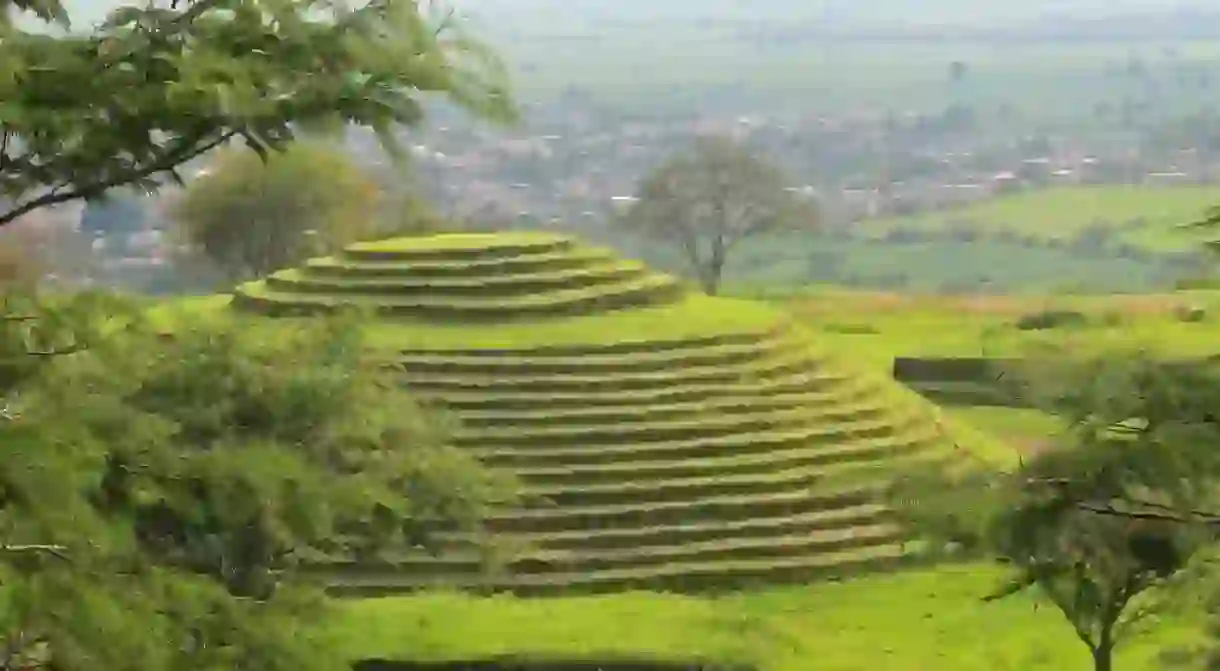A Guide to The Guachimontones, Western Mexico's Greatest Archaeological Wonder

The eastern region of Mexico is scattered with the famous Mayan ruins of Chichen Itza, Tulum, Palenque, and many others, but the western portion of the country also contains the remnants of lost civilizations that flourished long before the Spanish touched down in the New World. Los Guachimontones, located an hour outside Guadalajara, is the jewel in western Mexico’s archaeological crown. Formed by the Teuchitlán culture, the site is known for its curious “round pyramid” structures.
The Discovery of the Site
Los Guachimontones were discovered in 1969 by the American archaeologist Dr. Phil Weigand, who acquired the funds to begin full excavation in 1996. Little was known in the early days about who had built the pyramids. Conspiracy theories abounded that they were built by the Jalisco government in an effort to attract more tourists to the state. Some even suggested that the strange-looking pyramids were alien in origin.

The Teuchitlan Tradition
Researchers eventually proved that the pyramids were constructed approximately 2,000 years ago by the Teuchitlán culture that had thrived in the Tequila Valley region between 300 BC and 900 AD. At one time, this area was home to more than 40,000 people. Very little is known about this society except that the word Teuchitlán means, “a place for the divine,” and the community was dedicated to agriculture and fishing.
This culture is notable for its use of conical step pyramids. Apart from one other smaller pyramid in Mexico City, these are the only round pyramids in the world. The largest pyramid at Los Guachimontones is more than 60 feet (18 metres) tall and has 52 steps, corresponding to the number of weeks in a year. Archaeologists have speculated that a post would have been placed in a hole at the summit for volador flying ceremonies.

The reconstructed site and its accompanying interpretive center were opened to teach people about this lost Mexican culture. In recognition of the importance of this mission, UNESCO has added the whole region to its World Heritage List.
The site also includes two ball courts, used to stage Mesoamerican ball games. Competitors used their hips to control the ball and smash it from one end of the court to the other. The sport was sometimes used to settle territorial disputes or inheritance rights, and is also thought to have had religious connotations.
Getting There
The site is located 26 miles (42 kilometers) west of Guadalajara and can be reached by bus or taxi. The bus leaves Guadalajara’s old bus station (the Antigua Central Camionera) at Los Angeles 218, and costs around MXN$50 (US$3). Taxis and buses drop visitors at the entrance to the town of Teuchitlan. The hike to the ruins is quite long and steep. Visitors should bring water and sunscreen, because there is little shade en route. Entrance to the site is free, but a ticket to the Centro Interpretativo costs MXN$30 (US$2).
Los Guachimontones, Carretera Estatal 604 Guadalajara-San Marcos, Teuchitlan, Jalisco, +52 3336138224
Eating
After exploring the ruins, there are several excellent restaurants along the shores of Lake La Vega back in the town of Teuchitlan. The Monte Carlo is the best of these and serves delicious seafood in a stylish lakeside setting.
https://www.instagram.com/p/BQ_PlzAB4Sx/?taken-at=169790699873206













